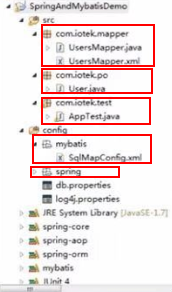Spring(4)之 Spring與Mybatis整合
Spring與Mybatis整合
- 整合思路
Spring管理:Mybatis的 SqlSessionFactory、Mapper
第一步:整合dao
第二步:新增事務管理
第三步:整合service、Spring管理Service介面、service通過IOC容器呼叫Dao(mapper) - jar 包
① mybatis 的 jar包
(mybatis : mybatis、log4j、cglib、slf4j、javassist、asm)
② spring 的 jar包:
(spring-core: spring-core、spring-context、spring-beans、spring-expression、spring-logging、aopalliance)
(spring-aop:aspectjrt.jar、aspectjweaver.jar、spring-aop)
(spring-jdbc: spring-jdbc、spring-orm、spring-tx、mysql-connector、c3p0)
③ mybatis和 spring的整合包
(mybatis-spring: mybatis-spring
④ 資料庫驅動包 - 工程結構
配置檔案:
1.SqlMapConfig.xml —mybais配置檔案:配置別名、setting、mapper(一般在spring配置檔案中配置)
2.Spring配置檔案(可寫在一個配置檔案也可以分開寫):
bean.xml
bean-dao.xml—配置資料來源、SqlSessionFactory、Mapper掃描器
bean-service.xml —配置 service
bean-transaction.xml —事務管理 - Mybatis與Spring整合的過程中:
Spring對於 Mybatis中 Mapper的管理方式有兩種(兩者都是mybatis和spring整合包中的類 [ 如下方class="org.mybatis.spring… ]):(下方 1.2 bean-dao.xml 中):
①. MapperFactoryBean:
缺點:如果有多個 Mapper介面物件,則要配置多次;
<bean id="userMapper" class="org.mybatis.spring.mapper.MapperFactoryBean"> <property name="mapperInterface" value="com.asd.mapper.UserMapper"></property> <property name="sqlSessionFactory" ref="sqlSessionFactory"></property> </bean>
②. MapperScannerConfigurer:
可以一次性配置多個 Mapper介面物件;
(第二種管理 Mapper的方式,使用 MapperScannerConfigurer:自動生成代理物件,sqlSessionFactory 可以不寫; MapperScannerConfigurer: 是Mapper掃描器,將指定包下的mapper介面自動建立物件,bean的id是mapper的類名,首字母小寫; <property name=“basePackage”…>: 配置掃描包的路徑,要求:mapper.xml與mapper.java同名且同目錄;<property name=“sqlSessionFactoryBeanName”…>: 使用 sqlSessionFactory;)
<bean class="org.mybatis.spring.mapper.MapperScannerConfigurer">
<property name="basePackage" value="com.asd.mapper"/>
//<property name="sqlSessionFactoryBeanName" value="sqlSessionFactory"/>
</bean>
eg:工程目錄結構:

eg:1.1 SqlMapConfig.xml
<?xml version="1.0" encoding="UTF-8" ?>
<!DOCTYPE configuration
PUBLIC "-//mybatis.org//DTD Config 3.0//EN"
"http://mybatis.org/dtd/mybatis-3-config.dtd">
<configuration>
<typeAliase>
<package name="com.iotek.po"/>
</typeAliase>
<!-- 若是讓Spring來管理,此處可以不配置 -->
<!-- <mapper>
<package name="com.asd.mapper"/>
</mapper>-->
</configuration>
1.2 bean.xml
<beans xmlns="http://www.springframework.org/schema/beans"
xmlns:p="http://www.springframework.org/schema/p"
xmlns:xsi="http://www.w3.org/2001/XMLSchema-instance"
xmlns:context="http://www.springframework.org/schema/context" xmlns:tx="http://www.springframework.org/schema/tx"
xmlns:aop="http://www.springframework.org/schema/aop"
xsi:schemaLocation="http://www.springframework.org/schema/beans
http://www.springframework.org/schema/beans/spring-beans.xsd http://www.springframework.org/schema/context http://www.springframework.org/schema/context/spring-context.xsd http://www.springframework.org/schema/tx http://www.springframework.org/schema/tx/spring-tx.xsd http://www.springframework.org/schema/aop http://www.springframework.org/schema/aop/spring-aop.xsd">
<!-- 開啟註解掃描 -->
<context:component-scan base-package="com.asd"></context:component-scan>
</beans>
1.2 bean-dao.xml
<beans xmlns="http://www.springframework.org/schema/beans"
xmlns:p="http://www.springframework.org/schema/p"
xmlns:xsi="http://www.w3.org/2001/XMLSchema-instance"
xmlns:context="http://www.springframework.org/schema/context" xmlns:tx="http://www.springframework.org/schema/tx"
xmlns:aop="http://www.springframework.org/schema/aop"
xsi:schemaLocation="http://www.springframework.org/schema/beans
http://www.springframework.org/schema/beans/spring-beans.xsd http://www.springframework.org/schema/context http://www.springframework.org/schema/context/spring-context.xsd http://www.springframework.org/schema/tx http://www.springframework.org/schema/tx/spring-tx.xsd http://www.springframework.org/schema/aop http://www.springframework.org/schema/aop/spring-aop.xsd">
<!-- 1. 資料庫連線池 -->
<!-- 法一: -->
<!-- <bean id="dataSource" class="com.mchange.v2.com.mchange.v2.c3p0.ComboPooledDataSource">
<property name="driverClass" value="com.mysql.jdbc.Driver"></property>
<property name="jdbcUrl" value="jdbc:mysql://localhost:3306/test"></property>
<property name="user" value="root"></property>
<property name="password" value="12345"></property>
</bean> -->
<!-- 法二: -->
<context:property-placeholder location="classpath:db.properties"/>
<bean id="dataSource" class="com.mchange.v2.com.mchange.v2.c3p0.ComboPooledDataSource">
<property name="driverClass" value="${jdbc.driver}"></property>
<property name="jdbcUrl" value="${jdbc.url}"></property>
<property name="user" value="${jdbc.username}"></property>
<property name="password" value="${jdbc.password}"></property>
</bean>
<!-- 2. SqlSessionFactory -->
<bean id="sqlSessionFactory" class="org.mybatis.spring.SqlSessionFactoryBean">
<!-- 配置資料來源 -->
<property name="dataSource" ref="dataSource"></property>
<!-- 載入mybatis的配置檔案 -->
<property name="configLocation" value="classpath:mybatis/SqlMapConfig.xml"></property>
</bean>
<!-- 3. Mapper配置 -->
<!-- 法二(常用)簡化版:第二種管理Mapper的方式,使用MapperScannerConfigurer:自動生成代理物件,sqlSessionFactory 可以不寫-->
<bean class="org.mybatis.spring.mapper.MapperScannerConfigurer">
<property name="basePackage" value="com.asd.mapper"/>
</bean>
<!-- 法二(常用)未簡化版:-->
<!-- MapperScannerConfigurer:是Mapper掃描器,將指定包下的mapper介面自動建立物件,bean的id是mapper的類名(首字母小寫) -->
<!-- <bean class="org.mybatis.spring.mapper.MapperScannerConfigurer">
<!-- 配置掃描包的路徑,要求:mapper.xml與mapper.java同名且同目錄 -->
<property name="basePackage" value="com.asd.mapper"/>
<!-- 使用sqlSessionFactory -->
<property name="sqlSessionFactoryBeanName" value="sqlSessionFactory"/>
</bean>-->
<!-- 法一: 第一種管理Mapper的方式,使用MapperFactoryBean -->
<!-- <bean id="userMapper" class="org.mybatis.spring.mapper.MapperFactoryBean">
<property name="mapperInterface" value="com.asd.mapper.UserMapper"></property>
<property name="sqlSessionFactory" ref="sqlSessionFactory"></property>
</bean>
<bean id="userMapper2" class="org.mybatis.spring.mapper.MapperFactoryBean">
<property name="mapperInterface" value="com.asd.mapper.OrderMapper"></property>
<property name="sqlSessionFactory" ref="sqlSessionFactory"></property>
</bean>-->
</beans>
1.2 ’ db.properties
jdbc.driver=com.mysql.jdbc.Driver
jdbc.url=jdbc:mysql://localhost:3306/test
jdbc.username=root
jdbc.password=12345
1.2’ bean-service.xml
(法一:可以使用 xml 方式生成 service的 bean物件;法二:也可以使用註解掃描的方式生成 Service類的物件:則下方 1.5 UserService.java 中可以使用@Service的類註解;)
<beans xmlns="http://www.springframework.org/schema/beans"
xmlns:p="http://www.springframework.org/schema/p"
xmlns:xsi="http://www.w3.org/2001/XMLSchema-instance"
xmlns:context="http://www.springframework.org/schema/context" xmlns:tx="http://www.springframework.org/schema/tx"
xmlns:aop="http://www.springframework.org/schema/aop"
xsi:schemaLocation="http://www.springframework.org/schema/beans
http://www.springframework.org/schema/beans/spring-beans.xsd http://www.springframework.org/schema/context http://www.springframework.org/schema/context/spring-context.xsd http://www.springframework.org/schema/tx http://www.springframework.org/schema/tx/spring-tx.xsd http://www.springframework.org/schema/aop http://www.springframework.org/schema/aop/spring-aop.xsd">
<!-- 法一: -->
//<bean id="userService" class="com.asd.service.UserService"></bean>
<!-- 法二: -->
<context:component-scan base-package="com.asd"></context:component-scan>
</beans>
1.2’’ bean-transaction.xml
(事務管理兩種方式:第一種: 配置事務管理器、事務增強、AOP;
第二種: 開啟事務註解,這樣可以在需要配置事務的類、或者方法上直接使用註解。)
<beans xmlns="http://www.springframework.org/schema/beans"
xmlns:p="http://www.springframework.org/schema/p"
xmlns:xsi="http://www.w3.org/2001/XMLSchema-instance"
xmlns:context="http://www.springframework.org/schema/context" xmlns:tx="http://www.springframework.org/schema/tx"
xmlns:aop="http://www.springframework.org/schema/aop"
xsi:schemaLocation="http://www.springframework.org/schema/beans
http://www.springframework.org/schema/beans/spring-beans.xsd http://www.springframework.org/schema/context http://www.springframework.org/schema/context/spring-context.xsd http://www.springframework.org/schema/tx http://www.springframework.org/schema/tx/spring-tx.xsd http://www.springframework.org/schema/aop http://www.springframework.org/schema/aop/spring-aop.xsd">
<!-- 事務管理器 -->
<bean id="transactionManager" class="org.springframework.jdbc.datasource.DataSourceTransactionManager">
<property name="dataSource" ref="dataSource"></property>
</bean>
<!-- 法一: -->
<!-- 事務增強 -->
<!--<tx:advice id="txAdvice" transaction-manager="transactionManager">
<tx:attributes>
<tx:method name="save" read-only="false"/>
<tx:method name="get*" read-only="true"/>
<tx:method name="*" read-only="false"/>
</tx:attributes>
</tx:advice>
<!-- AOP(切面) -->
<aop:config>
<aop:advisor advice-ref="txAdvice" point-cut="execution(* com.asd.service.*.*(..))"/>
</aop:config> -->
<!-- 法二: -->
//使用此方法開啟事務後,可以直接在下方1.5 UserService.java的類或者方法上使用@Transactional註解
<tx:annotation-driven transaction-manager="transactionManager"/>
</beans>
1.3 User.java
public class User{
private int id;
private String username;
private int age;
set、get();
}
1.4 UserMapper.java
public interface UserMapper{
public User findUserById(int id)throws Exception;
}
1.4’ UserMapper.xml
<?xml version="1.0" encoding="UTF-8" ?>
<!DOCTYPE mapper
PUBLIC "-//mybatis.org//DTD Mapper 3.0//EN"
"http://mybatis.org/dtd/mybatis-3-mapper.dtd">
<mapper namespace="com.asd.mapper.UserMapper">
<select id="findUserById" parameterType="int" resultType="user">
select * from user where id=#{id}
</select>
</mapper>
1.5 UserService.java
(因為1.2 bean-dao.xml 中有 mapper的配置,即Mapper掃描器,掃描指定包下的mapper介面自動建立 mapper物件(bean的id是mapper的類名,首字母小寫),所以此處生成了userMapper可以使用@Autowired註解來自動注入; 1.2’ bean-service.xml 中使用 xml方式生成 UserService的 bean物件;)對於:
@Service 此註解在上方1.2’ bean-service.xml中(法二)開啟註解掃描後才可使用;
@Autowired 此註解無需上方1.2’ bean-service.xml中(法二)開啟註解掃描後才可使用,因為1.2 bean-dao.xml 中有 mapper掃描器,可自動生成 mapper物件了;
@Service
@Transactional
public class UserService{
@Autowired //自動注入
private UserMapper userMapper;
public User findUserById(int id) throws Exception{
return userMapper.findUserById(id);
}
}
Test.java
(此 .getBean(“sqlSessionFactory”)是上面1.2 bean-dao.xml中生成的 sqlSessionFactory的 bean物件;)
public class Test{
ApplicationContext applicationContext=new ClassPathXmlApplicationContext("spring/bean.xml","spring/bean-*.xml");
@Test
public void test throws Exception{
SqlSessionFactory factory=(SqlSessionFactory) applicationContext.getBean("sqlSessionFactory");
SqlSession sqlSession=factory.openSession();
UserMapper userMapper=sqlSession.getMapper(UserMapper.class);
System.out.println(userMapper.findUserById(20));
}
@Test
public void test2 throws Exception{
UserService userService=(UserService)applicationContext.getBean("userService");
System.out.println(userService.findUserById(20));
//直接得到UserService的bean物件,通過userService呼叫方法
//【結果: User[id=20,username=測試3,age=2] 】
}
}
